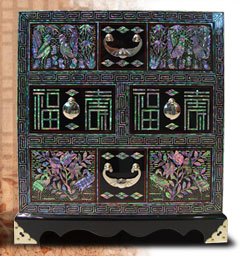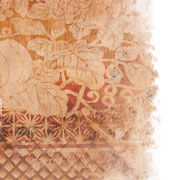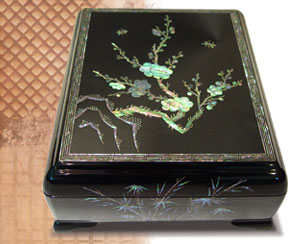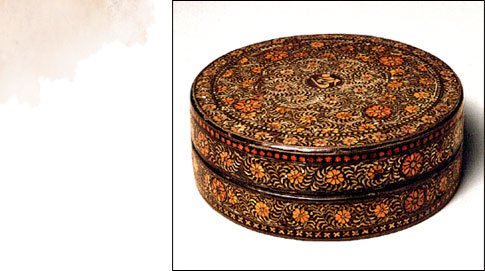 A seemingly worthless plain abalone shell covered with calcium carbonate is turned into a precious A seemingly worthless plain abalone shell covered with calcium carbonate is turned into a precious
 work of art displaying an amazing wealth of colors that have been hidden within it. Behind this incredible
work of art displaying an amazing wealth of colors that have been hidden within it. Behind this incredible
 metamorphosis lies the creativity and talent of a craftsman. Mother of pearl emits such wonderful colors
metamorphosis lies the creativity and talent of a craftsman. Mother of pearl emits such wonderful colors
 because the inner lining of the abalone shell, which it is made, consists of transparent crystals of calcium
because the inner lining of the abalone shell, which it is made, consists of transparent crystals of calcium
 carbonate. These crystals produce iridescent colors when light shines on them, like a prism. When the
carbonate. These crystals produce iridescent colors when light shines on them, like a prism. When the
 craftsman captures these numerous colors in small, delicate pieces, they are transformed into beautiful
craftsman captures these numerous colors in small, delicate pieces, they are transformed into beautiful
 flowers and birds, becoming precious gems lasting thousands of years.
flowers and birds, becoming precious gems lasting thousands of years.
 In East Asia, the technique of decorating objects with mother of pearl began during the Tang Dynasty In East Asia, the technique of decorating objects with mother of pearl began during the Tang Dynasty
 (618-907) in China. In Korea, it evolved into a unique art form called Najeon Chilgi around the arrival of
(618-907) in China. In Korea, it evolved into a unique art form called Najeon Chilgi around the arrival of
 the Goryeo Dynasty (918-1392). Because the Goryeo artisans produced such splendid works of art,
the Goryeo Dynasty (918-1392). Because the Goryeo artisans produced such splendid works of art,
 Najeon Chilgi soon became one of the dynasty’s major artistic contributions along with celadon ceramic
Najeon Chilgi soon became one of the dynasty’s major artistic contributions along with celadon ceramic
 ware and metal works. The most common and highly developed method of decorating the art works
ware and metal works. The most common and highly developed method of decorating the art works
 was to inlay the mother of pearl designs onto the pieces then glaze them with lacquer. Favorite
was to inlay the mother of pearl designs onto the pieces then glaze them with lacquer. Favorite
mother of pearl designs included flowers, particularly chrysanthemums and peonies, and exotic plants, such as the
arabesque “Tang Plant” pattern. Some craftsmen completely covered a piece with intricate designs as a sign of status
and wealth, an important quality to Goryeo society.
The exquisiteness and splendor of Goryeo’s Najeon Chilgi was highly praised by an envoy from China called Seo
Geung from the Sung Dynasty (960-1279). In his writing, “An Illustrated Book of Goryeo” ("Goryeo Dogyeong"), he said
that Goryeo’s Najeon Chilgi was: “…valuable enough because it is extremely exquisite and elaborate.” Other accounts
say that a Najeon Chilgi brush case from the Goryeo period was one of the most coveted items among the Sung literati
in China.
 Art historians today believe that what made Chinese writers, such as Seo Geung, buy Najeon Art historians today believe that what made Chinese writers, such as Seo Geung, buy Najeon
 Chilgi art was not only the ingenuity of the Korean artisans to retrieve the iridescent color from the
Chilgi art was not only the ingenuity of the Korean artisans to retrieve the iridescent color from the
 abalone shell but also their unique inlaying techniques to create such glorious designs. Inlaying
abalone shell but also their unique inlaying techniques to create such glorious designs. Inlaying
 such extraordinarily splendid and detailed mother of pearl motifs into the surface of hard wood,
such extraordinarily splendid and detailed mother of pearl motifs into the surface of hard wood,
 such as red sandalwood, was only achieved by the Korean craftsmen of the time. The Goryeo
such as red sandalwood, was only achieved by the Korean craftsmen of the time. The Goryeo
 artisans had eagerly met the challenges the new techniques generated head on and through
artisans had eagerly met the challenges the new techniques generated head on and through
 their diligence and creativity were able to find methods to solve those dilemmas. By then,
their diligence and creativity were able to find methods to solve those dilemmas. By then,
 the Goryeo period already boasted a long tradition of advanced lacquer ware craft.
the Goryeo period already boasted a long tradition of advanced lacquer ware craft.
 The reputation and artistic supremacy of Goryeo Najeon Chilgi art is indebted largely to The reputation and artistic supremacy of Goryeo Najeon Chilgi art is indebted largely to
 three techniques that the artisans of the time invented. The first of these techniques is to
three techniques that the artisans of the time invented. The first of these techniques is to
 use tiny mother of pearl pieces called ‘threads’ for inlaying patterns. Unlike other craftsmen,
use tiny mother of pearl pieces called ‘threads’ for inlaying patterns. Unlike other craftsmen,
 Goryeo artisans decided to use tiny mother-of pearl strips rather than large pieces, then
Goryeo artisans decided to use tiny mother-of pearl strips rather than large pieces, then
 inlaid them one-by-one to form the entire design, whether it was a flower or a geometric
inlaid them one-by-one to form the entire design, whether it was a flower or a geometric
shape. In fact, when the envoy, Seo Geung, praised the Najeon Chilgi art of Goryeo he made reference to this ingenious
method of making designs never seen before in China.
The second of Najeon Chilgi’s distinctive features was the combined use of wires, silver, bronze and brass with the
mother of pearl patterns. The wires, largely divided into single and twisted lines, were inlaid to form a boundary between
two different patterns or part of a figure, for example, a flower stem or a vein of a leaf. Such use of wires in combination
with mother of pearl significantly increased the means of artistic expression for Goryeo artisans.
The third element that distinguished Goryeo’s Najeon Chilgi from the mother of pearl craft in other parts of Asia was
the use of colorful tortoise shell pieces. Goryeo craftsmen found they could inlay treated tortoise shell, which was just
as valuable as mother of pearl. A Buddhist rosary case surviving from that era demonstrates how Najeon Chilgi artisans
of Goryeo used mother of pearl along with tortoise shell to make a magnificent work of art.
 Lacquered Rosary Case Inlaid with Mother of pearl Lacquered Rosary Case Inlaid with Mother of pearl
 and Tortoise-Shell Chrysanthemums and Arabesques and Tortoise-Shell Chrysanthemums and Arabesques
 Goryeo, 12th Century Goryeo, 12th Century
 This round case, complete with a cover, is believed to have
This round case, complete with a cover, is believed to have
 been a Buddhist rosary case because a rosary was discovered
been a Buddhist rosary case because a rosary was discovered
 in it. The lavishly embellished surface inlaid with a combination
in it. The lavishly embellished surface inlaid with a combination
 of mother of pearl, colored tortoise shell and metal wire is rare,
of mother of pearl, colored tortoise shell and metal wire is rare,
 and displays the aesthetic achievement of Goryeo’s Najeon Chilgi.
and displays the aesthetic achievement of Goryeo’s Najeon Chilgi.
 The elegant red and yellow tortoise shell pieces and iridescent
The elegant red and yellow tortoise shell pieces and iridescent
 mother of pearl strips create harmonious, exquisite patterns unlike
mother of pearl strips create harmonious, exquisite patterns unlike
 no other.
no other.
|



















